
Roy Fox Lichtenstein was an American pop artist. During the 1960's, along with Andy Warhol, Jasper Johns, and James Rosenquist, he became a leading figure in the new art movement. His work defined the premise of pop art through parody. Inspired by the comic strip, Lichtenstein produced precise compositions that documented while they parodied, often in a tongue-in-cheek manner. His work was influenced by popular advertising and the comic book style. His artwork was considered to be "disruptive". He described pop art as "not 'American' painting but actually industrial painting". His paintings were exhibited at the Leo Castelli Gallery in New York City.

Irving Novick was an American comics artist who worked almost continuously from 1939 until the 1990s.

Donald L. Heck was an American comics artist best known for co-creating the Marvel Comics characters Iron Man, the Wasp, Black Widow, Hawkeye and Wonder Man and for his long run penciling the Marvel superhero-team series The Avengers during the 1960s Silver Age of comic books.
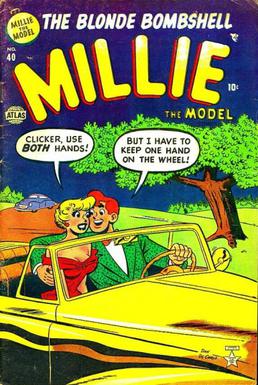
Millie the Model is Marvel Comics' longest-running humor title, first published by the company's 1940s predecessor, Timely Comics, and continuing through its 1950s forerunner, Atlas Comics, to 1970s Marvel. The comic book series deals with Millie Collins, an aspiring model working for the Hanover Modeling Agency.

Trina Robbins was an American cartoonist. She was an early participant in the underground comix movement, and one of the first women in the movement. She co-produced the 1970 underground comic It Ain't Me, Babe, which was the first comic book entirely created by women. She co-founded the Wimmen's Comix collective, wrote for Wonder Woman, and produced adaptations of Dope and The Silver Metal Lover. She was inducted into the Will Eisner Hall of Fame in 2013 and received Eisner Awards in 2017 and 2021.

Fiction House was an American publisher of pulp magazines and comic books that existed from the 1920s to the 1950s. It was founded by John B. "Jack" Kelly and John W. Glenister. By the late 1930s, the publisher was Thurman T. Scott. Its comics division was best known for its pinup-style good girl art, as epitomized by the company's most popular character, Sheena, Queen of the Jungle.
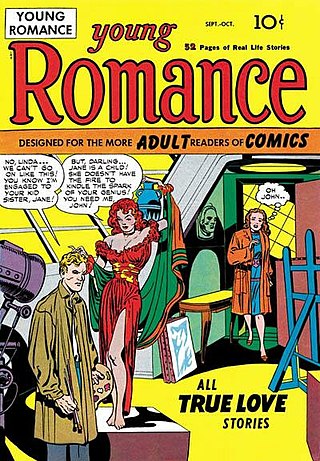
Romance comics are a genre of comic books that were most popular during the Golden Age of Comics. The market for comics, which had been growing rapidly throughout the 1940s, began to plummet after the end of World War II when military contracts to provide disposable reading matter to servicemen ended. This left many comic creators seeking new markets. In 1947, part of an effort to tap into new adult audiences, the romance comic genre was created by Joe Simon and Jack Kirby with the Crestwood Publications title Young Romance.

Girls' Love Stories was an American romance comic book magazine published by DC Comics in the United States. Started in 1949 as DC's first romance title, it ran for 180 issues, ending with the Nov-Dec 1973 issue. The stories covered such topics as girls worrying about getting a man, or marrying out of pressure, not love. Some of the early covers were photographs. The book's initial tagline was "True to Life!"
Charles J. "Jerry" Grandenetti was an American comic book artist and advertising art director, best known for his work with writer-artist Will Eisner on the celebrated comics feature "The Spirit", and for his decade-and-a-half run on many DC Comics war series. He also co-created the DC comic book Prez with Joe Simon.
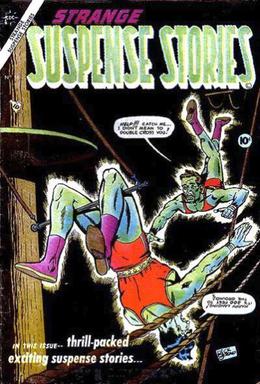
Strange Suspense Stories is a comic book that was published in two volumes by Fawcett Comics and Charlton Comics in the 1950s and 1960s. Starting out as a horror/suspense title, the first volume gradually moved toward eerie fantasy and weird science fiction, before ending as a vehicle for the superhero Captain Atom. The title's second volume was more in the horror/suspense vein. Altogether, 72 issues of Strange Suspense Stories were published.

Men of War is the name of several American comic book series published by DC Comics. For the most part, the series was a war comics anthology featuring fictional stories about the American military during World War II.
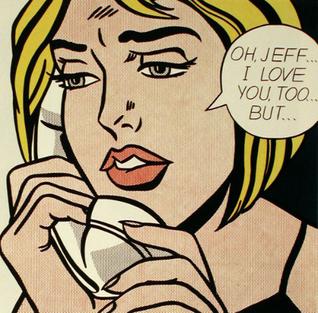
Oh, Jeff...I Love You, Too...But... is a 1964 oil and magna on canvas painting by Roy Lichtenstein. Like many of Lichtenstein's works, its title comes from the speech balloon in the painting.
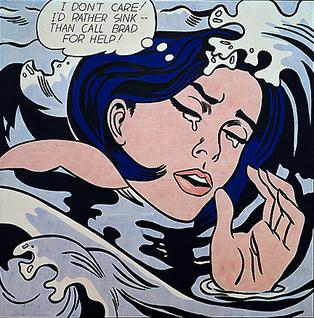
Drowning Girl is a 1963 American painting in oil and synthetic polymer paint on canvas by Roy Lichtenstein, based on original art by Tony Abruzzo. The painting is considered among Lichtenstein's most significant works, perhaps on a par with his acclaimed 1963 diptych Whaam!. One of the most representative paintings of the pop art movement, Drowning Girl was acquired by the Museum of Modern Art in 1971.

In the Car is a 1963 pop art painting by Roy Lichtenstein. The smaller, older of the two versions of this painting formerly held the record for highest auction price for a Lichtenstein painting. The larger version has been in the collection of the Scottish National Gallery of Modern Art in Edinburgh since 1980.

Crying Girl is the name of two different works by Roy Lichtenstein: a 1963 offset lithograph on lightweight, off-white wove paper and a 1964 porcelain enamel on steel.

Hopeless is a 1963 painting with oil paint and acrylic paint on canvas by Roy Lichtenstein. The painting is in the collection of the Kunstmuseum Basel.
Secret Hearts was a romance comic anthology published by DC Comics in the United States, primarily in the 1950s and '60s. A staple of the company's romance line, it was "one of the publisher's most successful and well-known romance titles."

Arthur F. Peddy was an American comic book and advertising artist best known for co-creating Quality Comics' superhero character Phantom Lady and Atlas Comics' jungle girl character Jann of the Jungle. He also was known for a stint as penciler of the superhero team the Justice Society of America for what later became DC Comics.
Angela Bocage is a bisexual comics creator who published mainly in the 1980s and 1990s. Bocage was active in the queer comics community during these decades, publishing in collections like Gay Comix,Strip AIDS USA, and Wimmen's Comix. Bocage also created, edited, and contributed comics to Real Girl, a comics anthology published by Fantagraphics.
Anthony Joseph "Tony" Abruzzo (1916–1990) was an American comic book artist. He is best known for his work in the romance comics field for National Periodicals, particularly Girls' Love Stories, for which he illustrated stories continuously from 1954 to 1972. In the early 1960s, pop artist Roy Lichtenstein derived many of his best-known works from the panels of romance comics that had been illustrated by Abruzzo.















